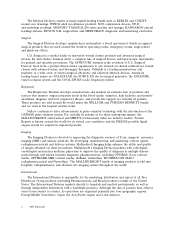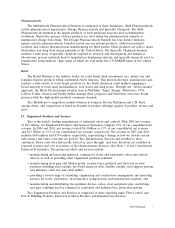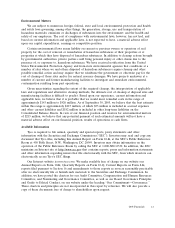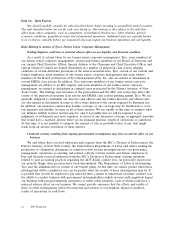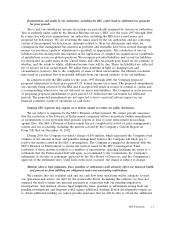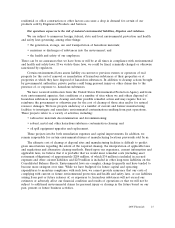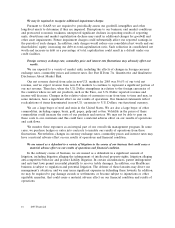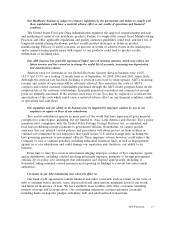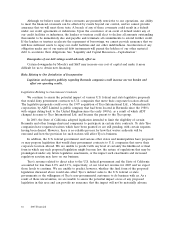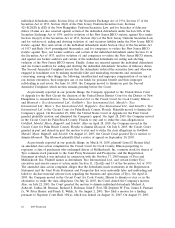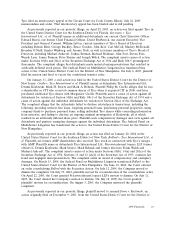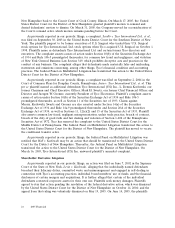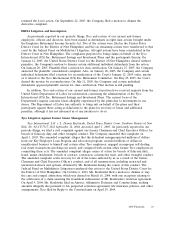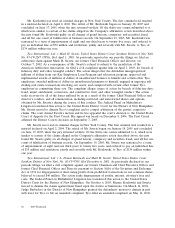ADT 2005 Annual Report Download - page 92
Download and view the complete annual report
Please find page 92 of the 2005 ADT annual report below. You can navigate through the pages in the report by either clicking on the pages listed below, or by using the keyword search tool below to find specific information within the annual report.We may be required to recognize additional impairment charges.
Pursuant to GAAP, we are required to periodically assess our goodwill, intangibles and other
long-lived assets to determine if they are impaired. Disruptions to our business, end market conditions
and protracted economic weakness, unexpected significant declines in operating results of reporting
units, divestitures and market capitalization declines may result in additional charges for goodwill and
other asset impairments. Future impairment charges could substantially affect our reported earnings in
the periods of such charges. In addition, such charges would reduce our consolidated net worth and our
shareholders’ equity, increasing our debt-to-total-capitalization ratio. Such reduction in consolidated net
worth and increase in debt as a percentage of total capitalization could result in a default under our
credit facilities.
Foreign currency exchange rate, commodity price and interest rate fluctuations may adversely affect our
results.
We are exposed to a variety of market risks, including the effects of changes in foreign currency
exchange rates, commodity prices and interest rates. See Part II Item 7A. Quantitative and Qualitative
Disclosures About Market Risk.
Our net revenue derived from sales in non-U.S. markets for 2005 was 50.6% of our total net
revenue, and we expect revenue from non-U.S. markets to continue to represent a significant portion of
our net revenue. Therefore, when the U.S. Dollar strengthens in relation to the foreign currencies of
the countries where we sell our products, such as the Euro, our U.S. Dollar reported revenue and
income will decrease. Changes in the relative values of currencies occur from time to time and may, in
some instances, have a significant effect on our results of operations. Our financial statements reflect
recalculations of items denominated in non-U.S. currencies to U.S. Dollars, our functional currency.
We are a large buyer of steel and resin in the United States. We are also a large buyer of other
commodities, including copper, brass, gold, paper, pulp and cotton. Volatility in the prices of these
commodities could increase the costs of our products and services. We may not be able to pass on
these costs to our customers and this could have a material adverse effect on our results of operations
and cash flows.
We monitor these exposures as an integral part of our overall risk management program. In some
cases, we purchase hedges or enter into contracts to insulate our results of operations from these
fluctuations. Nevertheless, changes in currency exchange rates, commodity prices and interest rates may
have a material adverse effect on our results of operations and financial condition.
We are named as a defendant to a variety of litigation in the course of our business that could cause a
material adverse effect on our results of operations and financial condition.
In the ordinary course of business, we are named as a defendant in a significant amount of
litigation, including litigation alleging the infringement of intellectual property rights, litigation alleging
anti-competitive behavior and product liability litigation. In certain circumstances, patent infringement
and anti-trust laws permit successful plaintiffs to recover treble damages. In addition, our Healthcare
business is subject to regulation and potential litigation. The defense of these lawsuits may divert our
management’s attention, and we may incur significant expenses in defending these lawsuits. In addition,
we may be required to pay damage awards or settlements, or become subject to injunctions or other
equitable remedies, that could cause a material adverse effect on our financial condition and results of
operations.
16 2005 Financials


